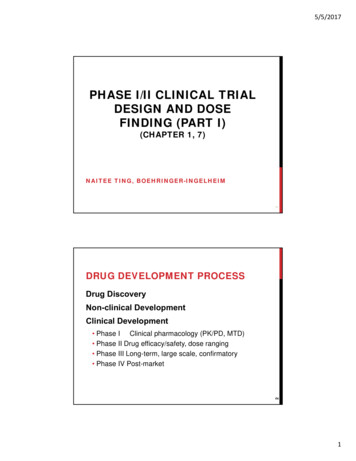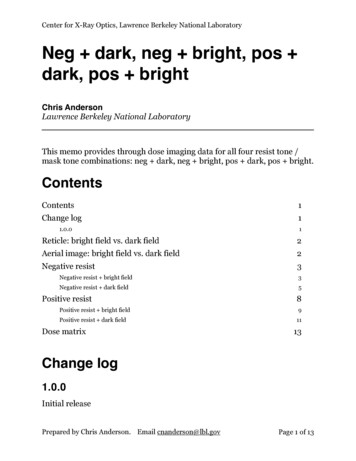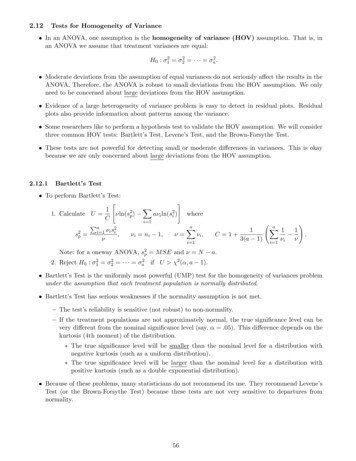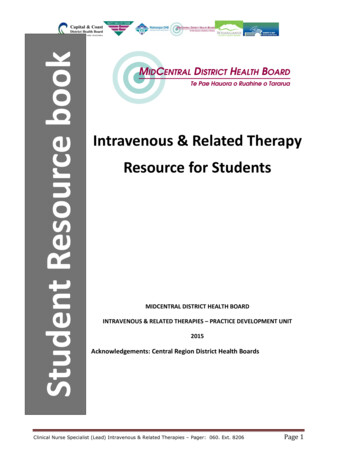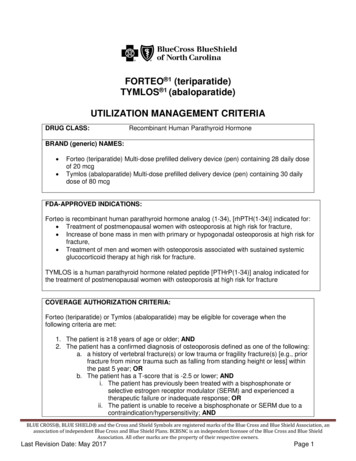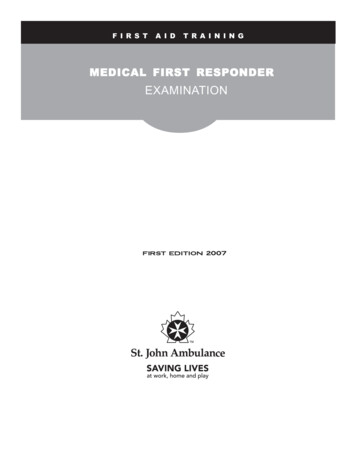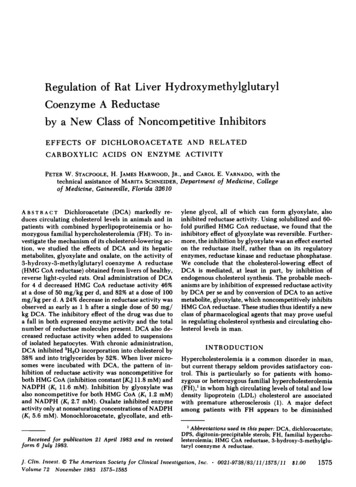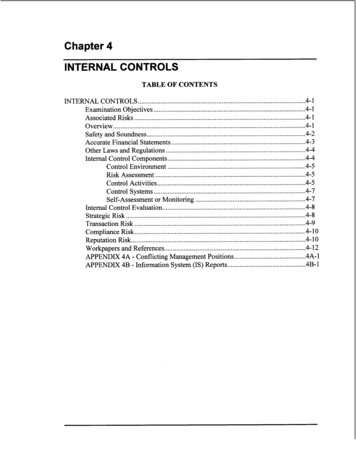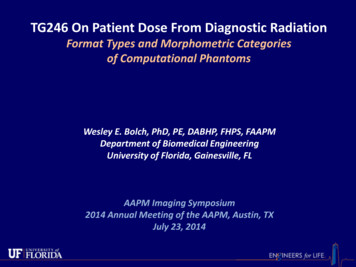
Transcription
TG246 On Patient Dose From Diagnostic RadiationFormat Types and Morphometric Categoriesof Computational PhantomsWesley E. Bolch, PhD, PE, DABHP, FHPS, FAAPMDepartment of Biomedical EngineeringUniversity of Florida, Gainesville, FLAAPM Imaging Symposium2014 Annual Meeting of the AAPM, Austin, TXJuly 23, 2014
Computational Anatomic PhantomsEssential tool for organ dose assessment Definition - Computerized representation of human anatomy for use inradiation transport simulation of the medical imaging or radiation therapyprocedure Need for phantoms vary with the medical application– Nuclear Medicine 3D patient images generally not available, especially for children– Diagnostic radiology and interventional fluoroscopy no 3D image– Computed tomography 3D patient images available, problem – organ segmentation No anatomic information at edges of scan coverage– Radiotherapy Needed for characterizing out-of-field organ doses Examples – IMRT scatter, proton therapy neutron dose
Computational Anatomic PhantomsPhantom Types and Morphometric Categories Phantom Format Types Stylized (or mathematical) phantoms Voxel (or tomographic) phantoms Hybrid (or NURBS/PM) phantoms
Format Types - Stylized Phantoms1960sStylizedPhantomHeartFlexible but anatomicallyunrealisticLiverSpleenStomachSmall intestineAscending colonDescending colonUrinary bladderAnatomy of ORNL stylized adult phantom
Selective History of Stylized Phantoms
Format Types - Voxel Phantoms1980sVoxelPhantomAnatomically Realisticbut not very flexibleLungsHeartLiverColonSmall intestineUrinary bladderTestesAnatomy of Korean male voxel phantom
Selective History of Voxel Phantoms
Selective History of Voxel Phantoms
Selective History of Voxel Phantoms
Selective History of Voxel Phantoms
Format Types – Hybrid Phantoms2000sHybridPhantomLungsHeartRealistic and flexibleLiverStomachColonSmall intestineUrinary bladderAnatomy of UF hybrid adult male phantom
Selective History of Hybrid Phantoms
Selective History of Hybrid Phantoms
Hybrid Phantom ConstructionExample of the process used at the University of FloridaSegment patientCT images using3D-DOCTORTMMake NURBSmodel frompolygon mesh usingRhinocerosTMSegmentationNURBS modelingVoxelizer Algorithm - See Phys Med Biol 52 (12) 3309-3333 (2007)PolygonizationVoxelizationConvert intopolygon mesh using3D-DOCTORTMConvert NURBSmodel into voxelmodel usingMATLAB codeVoxelizer
Hybrid Phantom ConstructionAdvantages of Hybrid over Voxel Phantoms – 3D shape of the body and organsLung of original UF voxelnewborn phantomLung models of voxelized UFnewborn hybrid phantom
Computational Anatomic PhantomsPhantom Types and Categories Phantom Format Types Stylized (or mathematical) phantoms Voxel (or tomographic) phantoms Hybrid (or NURBS/PM) phantoms Phantom Morphometric Categories Reference (50th percentile individual, patient matching by age only) Patient-dependent (patient matched by nearest height / weight) Patient-sculpted (patient matched to height, weight, and body contour) Patient-specific (phantom uniquely matching patient morphometry)
Morphometric Categories – Reference PhantomsReference Individual - An idealised male or female with characteristicsdefined by the ICRP for the purpose of radiological protection, and withthe anatomical and physiological characteristics defined in ICRPPublication 89 (ICRP 2002).Note – While organ size / mass are specified in an ICRP reference phantom,organ shape, depth, position within the body are not defined by reference values
Reference Phantoms Used by the ICRPEssentially all dose coefficients published to date by the ICRP are based oncomputational data generated using the ORNL stylized phantom series.ORNL TM-8381Cristy & EckermanExceptions include the following ICRP/ICRU Reports ICRP Publication 116 – External Dose Coefficients (2010) ICRU Report 84 – Cosmic Radiation Exposure to Aircrew (2010) ICRP Publication 123 – Assessment of Radiation Exposure of Astronauts in Space (2013)
Reference Phantoms Adopted by the ICRPICRP Publication 110 – Adult Reference Computational PhantomsUpcoming Publications from ICRP using the Publication 110 Phantoms Reference specific absorbed fractions (SAF) for internal dosimetry Dose coefficients for radionuclide internal dosimetry following inhalation / ingestion
Reference Phantoms Adopted by the ICRPIn April 2014, ICRP established that its future reference phantoms forpediatric individuals would be based upon the UF series of hybrid phantoms
Morphometric Categories – Patient Dependent PhantomsDefinition Expanded library of reference phantoms covering a range of height / weight percentilesICRP - basedUFHADMNHANES - basedUFHADMNHANES Database7320 individualsAgeWeightStanding heightSitting heightBMIBiacromial breadthBiiliac breadthArm circumferenceWaist circumferenceButtocks circumferenceThigh circumferenceUS based phantom library10% 25% 50% 75% 90%Reference weights @ 1 or morefixed anthropometric parameter(s)
Morphometric Categories – Patient Dependent PhantomsPatient-Dependent Hybrid Phantoms – UF SeriesGeyer et al. – Phys Med Biol (2014)
New UF/NCI Phantom Library - ChildrenPhantom for eachheight/weightcombination furthermatching averagevalues of bodycircumference fromCDC survey data85 pediatric males73 pediatric females
New UF/NCI Phantom Library - AdultsPhantom for eachheight/weightcombination furthermatching averagevalues of bodycircumference fromCDC survey data100 adult males93 adult females
Variations in CT organ dose with BMI
Applications to Skin Dose Mapping𝑫𝑫𝒔𝒔𝒔𝒔𝒔𝒔𝒔𝒔 ���𝒓 𝑪𝑪𝑪𝑪 ��𝝁𝒆𝒆𝒆𝒆 𝑩𝑩𝑩𝑩𝑩𝑩 ��𝒂𝒂𝒂 𝒆𝒆 𝝁𝝁𝝁𝝁Skin Dose Maps onMorphometryMatched HybridPhantom
Applications to Skin Dose Mapping𝑫𝑫𝒔𝒔𝒔𝒔𝒔𝒔𝒔𝒔 ���𝒓 𝑪𝑪𝑪𝑪 ��𝝁𝒆𝒆𝒆𝒆 𝑩𝑩𝑩𝑩𝑩𝑩 ��𝒂𝒂𝒂 𝒆𝒆 𝝁𝝁𝝁𝝁
Applications to Organ DosimetryFraction of total organ doses when considering only irradiation events that register acumulative reference air kerma in the 90, 85, 75, 50, 40, and 25th percentile andabove. Total number of irradiation events was 117.
Morphometric Categories – Patient-Sculpted Phantoms The goal is to reshape the outer body contour of your reference or patient-dependentphantom to uniquely match that of the individual patient By definition, no individual changes are made to internal organs – both in terms of theirrelative shapes and positions. However, as the torso or sitting height is adjusted to higher or lower values, thecollection of internal organ volumes in the torso are increased or decreased,accordingly. This scaling can be 1D (z), 2D (xy), or 3D (xyz) Arms and legs can be adjusted separately if the phantom is designed as such. Thus,patient total height and sitting height can be matched together. Once the sitting or torso height is matched, body thicknesses can be adjusted touniquely match those seen in the individual patient. The additional phantom tissuevolumes below the skin are then typically assigned to Subcutaneous fat – OR – Residual soft tissues – combination of subcutaneous fat, muscle, connective tissue
Morphometric Categories – Patient-Sculpted Phantoms Possible methods of obtaining targeted outer body contour Visual coupling of patient body contour to those of an extensive phantom library.Example – patient “looks” like UF phantom 129, and so we will use thatphantom for assigning organ doses in CT. Make tape measurements of arm, thigh, head, chest, abdomen, pelviscircumferences. Next, one would manually or possibility automatically throughRhino script files, “rescale” the closest matched phantom from an existinglibrary. Sculpt the patient phantom using existing CT image or perhaps a IR scanningsystems as used in radiotherapy. Use that body contour image to “adjust” thebody contour of the closest matched phantom from an existing library. For skindosimetry in FGI, the contour image is all that is needed for skin dose mapping.
Morphometric Categories – Patient-Specific PhantomsHoly Grail of Radiation Dosimetry! Cannot be done if you don’t have the patient image! Even if you have these images, the problem is partial body coverage and segmentation! No global automation algorithms presently available Specialized algorithms have been developed for select organs as part of TPS However, one needs to ask the question – “How patient specific does my organ doses haveto be?” In other words, what am I going to do with that dose? If it is to be used to estimate cancer incidence risks, you need to appreciate from wherethese risk coefficients are derived. Radiation epidemiology studies in which organ doses are crudely estimated bycombinations of air kerma estimates and dose coefficients from ORNL stylizedphantoms. In conclusion, perhaps patient-specific phantoms are not needed, and patientdependent libraries, with optional exterior sculpting, may be sufficient
Thank you for your attention!
Possible methods of obtaining targeted outer body contour Visual coupling of patient body contour to those of an extensive phantom library. Example - patient "looks" like UF phantom 129, and so we will use that phantom for assigning organ doses in CT. Make tape measurements of arm, thigh, head, chest, abdomen, pelvis circumferences.

